Wondering what you should do, see, and eat on a Barcelona 3 day itinerary? You’ve come to the right place! Read on for my tips to help you plan that perfect 3 days in Barcelona
With its reputation for being a city full of amazing architecture and amazing food, Barcelona had been on my list for a *long* time. So, when I stumbled upon a $250 flight there from San Francisco, I jumped on it. I was limited on vacation days, but couldn’t pass up the opportunity, so I decided to take a super quick, whirlwind trip and did Barcelona in 3 days.
I absolutely loved the city and being surrounded by Gaudi’s magical works, the laid-back beach town vibes, and consuming all the delicious tapas and sangrias I could handle. Needless to say, I had an amazing time during my Barcelona itinerary for 3 days.
Barcelona is one of the most visited cities in Europe and for good reason – there’s plenty of stunning architecture (plenty of Instagram-worthy sights!), so much incredible food, and is a vibrant city full of unique culture and history. It’s the perfect introduction to Spain, as it is so accessible, with so much to offer.
I loved it so much that when I decided to go back to Spain a few years later, I had to revisit it and include it as a stop on my itinerary.
Here are all the things you should do, see, and eat in a perfect Barcelona 3 day itinerary!
**This post contains affiliate links. This means that if you make a purchase or booking, I may receive a small commission at no additional cost to you. Pictures & Words is a participant in the Amazon Services LLC Associates Program, an affiliate advertising program designed to provide a means for us to earn fees by linking to amazon.com and affiliated sites at no cost to you.
Things to Know Before Spending 3 Days in Barcelona

How many days in Barcelona – is 3 days enough?
Barcelona is a relatively large city, and honestly much more spread out that I initially expected. There’s also sooooo much to do + see (and eat!), that you may be wondering “is 3 days in Barcelona enough?”
While you won’t get to see and experience everything that the city has to offer (I honestly don’t think you can do it all in a week!), a 3 day Barcelona itinerary will allow you to see many of the city’s highlights.
Three days in Barcelona is enough to see many of Gaudi’s masterpieces as well as the other unique architectural creations in the city, hit up its iconic attractions (such as the famous La Boqueria market), and eat just enough tapas to make you happy!
Sure, you’ll likely leave wishing you had more time here, but there’s always next time, am I right?
This is a pretty busy Barcelona travel itinerary, so you’ll get to make the maximize your time in the city and get to do and see a good amount! However, if you prefer a more relaxed itinerary, you may want to consider adding in an extra day.
If you only have 2 days, you’ll need to prioritize and remove a few things listed on this itinerary.
When to Visit Barcelona

A mild Mediterranean climate means that the weather in Barcelona is relatively pleasant year-round, making any time a good time to visit.
However, do note that some seasons are better others for visiting. To help you decide when to visit Barcelona, here is a breakdown to expect at various times in the year:
Summer (June-early September)
Barcelona’s peak tourist season is in the summer months (particularly June and July). This is when both crowds and temperatures are at their highest.
While it doesn’t get as hot as in other parts of Spain, particularly the cities in Andalusia (Seville, Granada, and Cordoba to name a few), it does see highs in the low to mid-80s Fahrenheit.
While I haven’t visited during summer (I tend to avoid the crowds + high prices), I have heard that the crowds are absolutely miserable during these months.
If you choose to visit during the summer months, be prepared – you must book tickets to the city’s most popular attractions weeks in advance!
Particularly, it is an absolute necessity to purchase tickets to the Sagrada Familia (you can do that here!) because not only is it one of the top attractions in Barcelona, it’s one of the most popular in all of Spain! It is also a good idea to buy tickets to other well-known attractions (Casa Batllo and Park Guell, to name a few) as well.

Spring (March-May) + Fall (late September-November)
Personally, I believe that the best time to plan a 3 day trip to Barcelona is during shoulder season – that is during the spring or fall.
Both times I’ve visited Barcelona have been in October, and I felt it was the perfect time to go! Temperatures were still warm (with highs in the 70s Fahrenheit/20s Celsius), but crowds had thinned out significantly at that point.
While it won’t be as busy as during the peak season, it is still a good idea to purchase attraction tickets in advance (at least a few days), to ensure that you get your pick of dates and times. Particularly, you’ll want to book the Sagrada Familia (again, it’s the #1 or 2 attraction in Spain, depending on the year),Casa Batllo and Park Guell at least a few days in advance of your Barcelona trip.
Winter (December-February)
The winter months are when you’ll see the fewest amount of visitors in Barcelona. It can almost feel like you have the city to yourself at times!
It’s not a bad time to visit, as Spain (much like Portugal) experiences relatively mild temperatures compared to many other destinations in Europe (i.e. Munich and Prague).
Expect highs to hover between the high 50s to low 60s Fahrenheit.
How to get to Barcelona

By Air
Most flights arrive at Barcelona’s main international airport, Josep Tarradellas Barcelona–El Prat Airport (BCN), which is served by many international carriers that connect it to major cities both in Europe and around the world.
Barcelona is served by low-cost carriers such as Level, which offers transatlantic flights at an affordable price point. It is also a hub for airlines such as Iberia and Europa, which offer connections to many destinations around Europe, making it one of the best entry points into Spain (and Europe).
The airport is located about 17km (~10.5 miles) outside of Barcelona. From here, you have a few options for getting into the city center:
- Aerobus: An easy and economical option, taking passengers to Placa de la Catalunya. From here, you can easily find connections into other parts of the city. The journey takes about 30-40 minutes (depending on traffic), and costs €8.90 one way, or €13.20. You can buy a ticket on the bus or from an agent, or use a self-service ticket machine (which accepts credit cards). Aerobus A1 serves Terminal 1, running every 5-10 minutes, while Aerobus A2 serves Terminal 2 (A, B, and C) and runs every 10 minutes from 6am-1am.
- Renfe R2 Nord train: The line R2 Nord train operated by Renfe (the national rail company) departs from Terminal 2B. If you are arriving in any other area of the airport, you must take a airport shuttle. Trains depart every 30 minutes, and the trip takes about 20-25 minutes. The train only makes two stops in the city center – Passeig de Gracia and the Sants train station. The fare is €4.60 – you can purchase is via the automated ticket machine at the airport. You can also buy a T-Casual ticket, which costs €11.35 and is valid for 10 rides on public transportation throughout your stay. If you plan to use public transportation often, consider buying a Hola Barcelona card for unlimited rides.
- Metro: The L9 Sud line makes stops at both Terminal 1 and 2. However, do note that this metro line does not make stops in the city center – you will have to transfer to a different line, depending on your final destination. The fare is €5.15. Note that you cannot use a T-Casual ticket on the L9, however, it is included in the Hola Barcelona card.
- Bus: You can also take a bus into the city center. TMB line 46 runs from the airport to Plaça España, and runs about every 17 minutes. There are stops at Terminal 2A, 2C, and 1. The trip takes about 40-55 minutes, depending on traffic (although it can take as little as 30 minutes if you’re lucky). The fare is €2.40, and you can use a T-Casual ticket as well as your Hola Barcelona card. If your flight arrives late at night, there is also a night bus (NitBus N17 and N18), which runs from 9:55pm-4:45am.
- Taxi: While Uber technically operates in Barcelona, there aren’t many cars available, making taxis a better option. You can easily hail a cab outside of the airport terminal. If you wish, you can also download the FreeNow or MyTaxi app, which works similarly to Uber but is for taxis. The fare is usually around €30-35, and the trip usually takes 25-30 minutes.

By Train
Traveling by train is honestly the way to go if you are journeying in between different cities in Spain. Trains are clean, efficient, and relaxing! However, if you are coming from other European cities, it is usually better to fly as it is much faster and often cheaper on budget airlines.
Barcelona’s main railway station is the Estacio Sants station, located about 3 kilometers from Placa Catalunya. Multiple metro lines also run through Sants, so it is an easy connection to the rest of the city. You can also hop in a taxi from here to get you wherever you need to go.
Renfe operates the national network of high-speed regional and high-speed AVE trains. While the AVE trains tend to be a bit more expensive, they are the way to go as they are sooo fast! We were impressed, as they go up to at speeds up to 300km/hour (wish the US had them!).
Do, however, note that the high-speed trains in Spain depend on a dynamic pricing model, which means that you should book your tickets as soon as you can in order to save money!
The Renfe site is notoriously difficult to figure out, especially if you are using a foreign credit card and don’t speak Spanish. We booked our train tickets through Omio and recommend you do the same – it was so easy to use and book, streamlined the booking process for us, and has all your tickets in one place. You pay a few Euros extra, but it was soooo worth it to save the hassle and headache!
Here are some average travel times via train from a few other major Spanish cities:
- Madrid: 2.5 hours
- Seville: 5.5 hours
- Granada: 6 hours, 45 minutes
- Valencia: 3 hours, 15 minutes
- Girona: 45 minutes
- Bilbao: 7 hours
By Bus
Long distance coach buses are also another option for traveling to Barcelona. Bus service connects Barcelona to many other cities in Spain, across Europe, and even Morocco.
The two main bus stations in Barcelona are Estación de Autobuses Barcelona Nord, located a few blocks from Parc de la Ciutadella, and Estació d’autobusos de Barcelona Sants, at which is also the main railway station and about 3 km from the city center.
Other Options
Barcelona is also connected via ferry to the Balearic Islands and Italy. You can also drive into the city – the A-7 is the main toll road from France, and the A-2 is the major toll-free road.

How to Get Around During Your Barcelona 3 Day Itinerary
One thing about Barcelona is that it is much bigger and spread out than you may initially think, so you can’t solely . Luckily, the city is well-connected and relatively easy to get around.
Here are your options for getting around during your 3 day trip to Barcelona:
- Walking: Many of Barcelona’s main tourist tourist attractions are clustered fairly close together, so if you plan your 3 day Barcelona itinerary correctly, you can walk once you arrive in a neighborhood. Grab a pair of comfortable walking shoes – walking was my main method of getting around while exploring Barcelona in 3 days. Wandering through the quaint streets of the city to get around was among one of my favorite activities there.
- Public transit: Barcelona has a fairly extensive public transportation system to help you get around. The metro is fast, easy, safe, and clean, and gets you around to mostly where you need to go
The metro serves most of the city on 8 underground color-coded lines. Stations are marked with a red diamond with an “M.” The metro runs from approximately 5am to midnight on weekdays, until 2am on Friday nights, and all night on Saturdays.
If you plan to use public transportation often during your 3 day itinerary for Barcelona, I highly recommend getting a Hola Barcelona card, which includes unlimited travel on the metro, buses, trams, and suburban trains. It also includes travel between the airport and city center on the Renfe R2 line or the metro, which is a big plus.
A single-ride ticket is €2.40. You can also get a T-Casual ticket ticket, which is good for 10 rides on and only costs €11.35. Pay attention to which side of the turnstile you are swiping your card! I kept swiping my T-Casual over and over at the wrong swiper, and lost a few rides on my ticket, until someone pointed out that I was using the wrong one. *face palm*
The city is also served by 80 bus lines. You can also get around via tram, cable car (to get to Montjuic), and funicular (which goes to Tibidabo).

- Hop-on, Hop-off Bus: I used to turn my nose up at these bus tours, but after going on one myself have since come to realize that they’re a fun and efficient way to see a city! The bus stops at all of the top attractions in the Barcelona, and you also get to take in the views and hear commentary about the city’s history and culture.
- Biking: Barcelona also has lots of designated bike lanes, so renting a bike to explore the city is also a good option. Here are some bike rental options.
- Taxi: While Uber technically operates in Barcelona, it is not a common thing and there are not many cars available. If you need to call a cab, I would suggest downloading the MyTaxi or FreeNow apps, which works in a similar fashion and can hail a taxi for you and tell the driver exactly where you need to go without any language barriers (and it tells you the exact fare as well).

Currency, Money, and Tipping in Barcelona
Like many European countries, Spain uses the Euro currency.
Credit cards are widely accepted in Barcelona, although it is good to have some cash on hand for smaller establishments (cash especially comes in handy when buying something at the stalls at the La Boqueria market).
It is best to get cash out of an ATM instead of at a currency exchange booth, as the rates are more favorable. You can find ATMs all over the city, or at the airport, train station – I took some out upon my arrival at the El Prat airport.
Like most of Europe, tipping is not expected in Barcelona, and sometimes gratuity is already bundled into your bill. If you feel like it, you can leave some extra coins or an extra 10% for great service.

Language in Barcelona
Barcelona is located in Catalonia, which is an autonomous region in Spain, with its own language and culture. This means that both Spanish and Catalan are the official languages of Barcelona. If you are looking for similarities between Spanish and Catalan, well, you won’t really find any – I found that they were completely different. In fact, I thought Catalan was more similar to French.
I found that my broken high school Spanish came in handy. While most people who work in establishments frequented by tourists speak at least some English, it’s not always great English, so I found that having a grasp on some basic Spanish came in useful.
I recommend brushing up on some basic Spanish phrases on Duolingo before you travel to Barcelona! I personally found it fun to bust out my Spanish and practice while in Barcelona.

Safety in Barcelona
Spain is known as one of the safest countries in Europe, and violent crime is extremely rare.
The first time I traveled to Barcelona, I was a solo female traveler. I found it relatively safe to walk around the city by myself, even at night (although I definitely do not recommending staying out too late at night). You should avoid walking around El Raval and the southern end of La Rambla late at night – although, I would say that when you are solo traveling, you should avoid walking around by yourself late at night anywhere, regardless.
As with any trip, please use caution and common sense while in Barcelona. As mentioned above, don’t walk around late at night. Don’t go anywhere with strangers. Don’t drink too much. Always watch your surroundings.
While violent crime is very rare in Barcelona, petty crime, such as pickpocketing is a major concern. This is especially true in tourist-heavy areas such as Las Ramblas and on the beach at Barceloneta, and on public transport.
It is said that the pickpockets here are *very* sneaky so keep your guard up at all times! Always, always, always keep a close eye on your belongings! I generally keep all my important belongings in a cross body that has a metal chain, that stays on my person at all times. A money belt or anti-theft purse may also be a good idea.
Also be aware that tourist scams are commons in areas such as Las Ramblas, so always keep your guard up!
On a side note: My first trip to Barcelona was while the Catalan independence movement was going on. While the media portrayed chaos and made it seem like there were violent mass protests going on everywhere in the city (I almost cancelled my trip because of this), I was pleasantly surprised to find that the city was calm and quiet once I arrived. In fact, the only sign of the movement going on that I could see were the flags representing either side that people hung on their balconies.
My point – take what the media says with a grain of salt, and do your own research. Be an educated traveler!
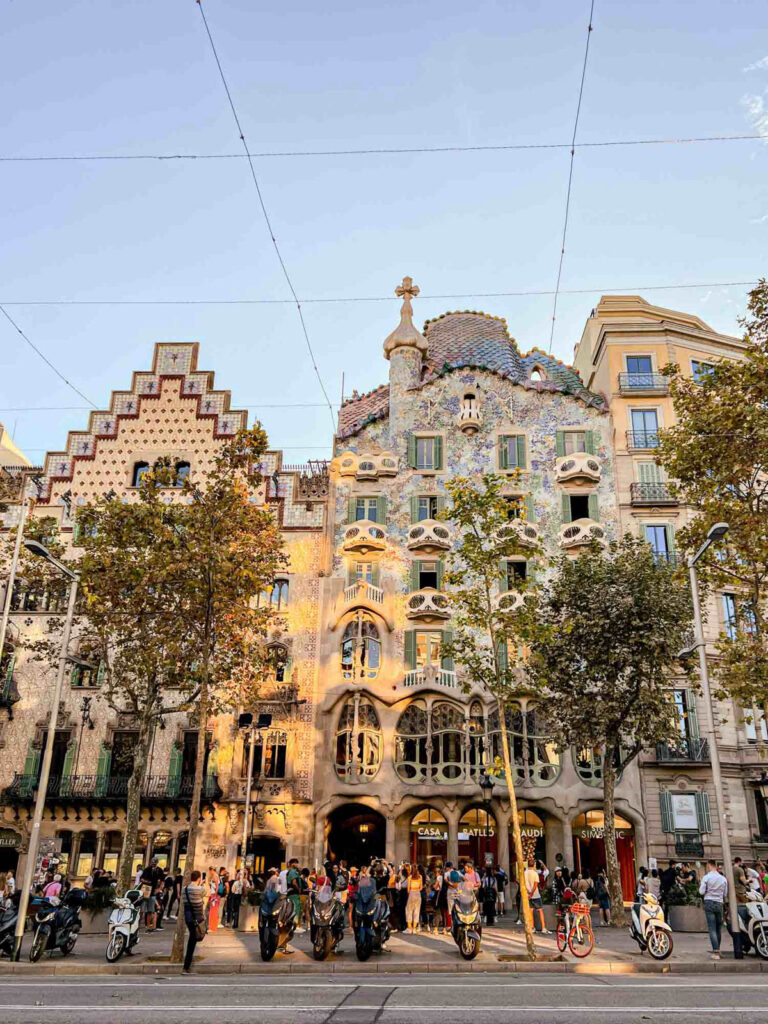
What to Pack for Your 3 Days in Barcelona
- Power adapter: Like the rest of Europe, Spain uses 230 V Type E plugs. If you’re coming from the United States, you’re going to need an adapter to plug in your devices. This one has several plugs, as well as USB ports.
- Comfortable shoes: You’re going to do a LOT of walking in Barcelona, so comfy shoes are a must! Also there’s a lot of cobblestone streets, so leave the heels at home. I love my Allbirds sneakers (like walking on clouds!) and flats (cute and comfy), as well as these Crocs sandals (which are actually really stylish, I swear!).
- Power bank: Keep your devices charged while you’re out and about – navigating and taking tons of photos can drain your phone battery super quick!
- Reusable water bottle: Like most of Europe, free tap water isn’t really a thing in Spain – and bottled water costs as much as the sangria, ha! Carry your own water with you so you can stay hydrated. I usually buy a giant bottle at a store and then fill up my bottle each day.
- Sunscreen: The sun gets pretty intense in Spain, so don’t forget the SPF! Also, here’s my favorite face sunscreen (and a top off).
Where to Stay During in Barcelona

There is no shortage of accommodations in Barcelona, to suit any style and budget. There are countless hostels, stylish boutique hotels, and luxury accommodations throughout the city.
Keep in mind that Airbnbs and other vacation rentals here are very much frowned upon, as they are often cited as a reason for driving up rents in the city. Many of the listed apartments are unlicensed and considered illegal. While there are still lots of spots available for booking on the site, keep in mind that it is not a preferred method of stay in Barcelona.
The best and more central areas to to stay are near Las Ramblas, El Raval, El Born, and the Gothic Quarter. L’Eixample is also relatively well-connected as well, with a few of the city’s top attractions and tons of restaurants nearby.
Staying in these neighborhoods will help you make it easy to get around – you can easily walk to most of the major attractions from there, or be super close to transit. The hotels I list below are all in these areas.

Here are some of my picks for where to stay in Barcelona:
- Casa Bonay: Where I stayed on my last trip to Barcelona, and absolutely loved! This hipster chic boutique hotel is located in a historical 1800s building in L’Eixample and manages to be stylish, fun, charming, and comfortable all at the same time. The rooms are on the smaller side, but there’s plenty of common spaces to hang out throughout the property, including a beautiful rooftop terrace. The staff here are super friendly and helpful as well, with plenty of recommendations for the city.
- Colon Hotel Barcelona: You can’t beat the location of Colon Hotel – it’s located right across from the Barcelona Cathedral, and conveniently located close to many of the city’s top attractions. It’s got a rooftop terrace with an insane view of the Barcelona Cathedral. Rooms are said to be spacious and comfortable as well.
- Chic & Basic Born: Chic and basic is a good way to describe this property, which has modern rooms at an affordable price point. You cannot beat the location in the heart of El Born, a short walk away from many of the city’s top sights.
- St. Christopher’s Inn: Where I stayed on my first trip to Barcelona. This hostel was perfect for my Barcelona solo trip – it is clean, comfortable, and fun. Several of my friends also stayed here and recommended it! All I needed was a clean and comfortable place to sleep at night, and St. Christopher’s definitely fit that criteria. Breakfast is included as well. St. Christopher’s puts on lots of fun activities for socializing, which is perfect for meeting and connecting with other travelers. The best part was the convenient location – it was literally a 3 minute walk from the Aerobus stop in Placa Catalunya, and there are 2 metro stops within 2 blocks in either direction.
The Perfect Barcelona 3 Day Itinerary
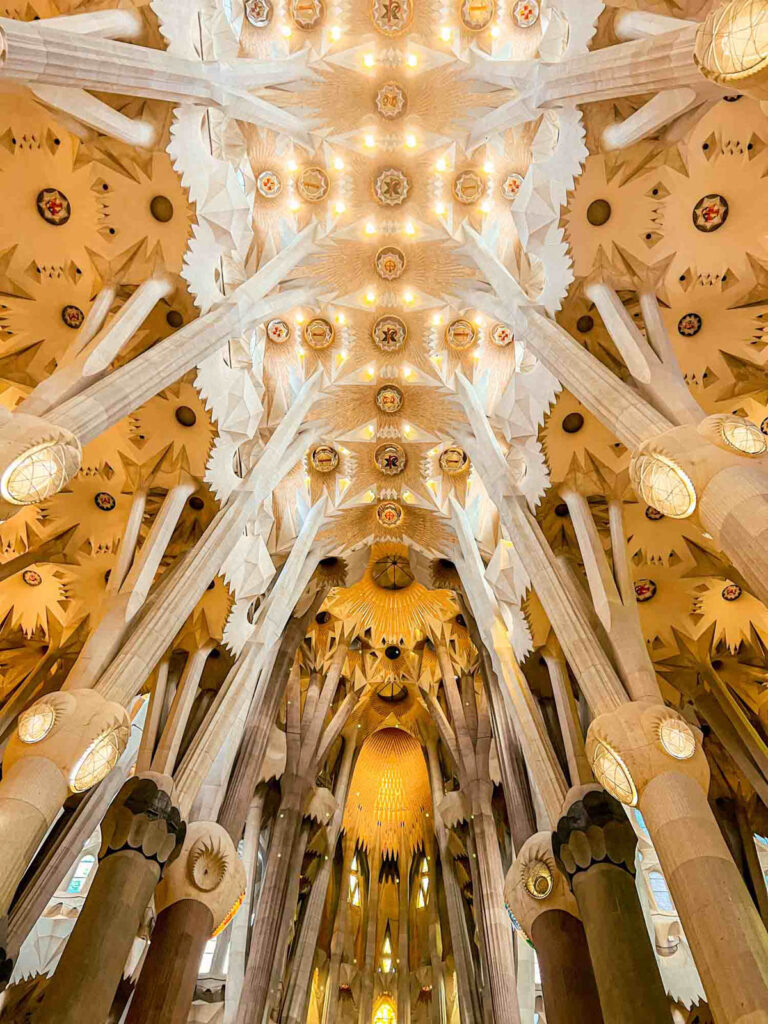

How to Save Money in Barcelona
Let’s face it – Barcelona is one of the most expensive cities in Europe, and attraction costs do add up!
One way to save a bit of money during your 3 day itinerary for Barcelona is to purchase the Go City Barcelona Pass. The pass includes admission into many of the city’s top attractions for a flat rate, which will allow you to save a bit of cash!
While these sorts passes sometimes include a bunch of lame attractions that you don’t actually want to see, I swear that the Barcelona Pass is different! You’ll gain free admission into many of the must-visit sites in Barcelona. Some of the included attractions that are on this 3 day Barcelona itinerary are Casa Batllo, Casa Mila, Sagrada Familia, Park Guell, and the Montjuic cable car to name a few. There’s tons of others included as well!
On my last trip to Barcelona, I actually totally forgot that I could buy the pass and was kicking myself as I showed up to each attraction and realizing that other people had the pass and had not only saved money, they were skipping the general admission line as well. Yes – the pass also comes with skip-the-line privileges at many attractions!
There are two options for passes, to best suit your needs. The first is all-inclusive option which allows free entry into as many attractions as you can visit in 2, 3, 4, or 5 days. The second option is an Explorer Pass, where you choose the number of included attractions you want to visit (2-7).
In any case, I highly recommend purchasing the Barcelona Pass to save a bit of money as you explore Barcelona – hey, extra money = extra tapas and sangrias, am I right? 😉
Barcelona Itinerary: DAY 1 (Iconic Barcelona sights)
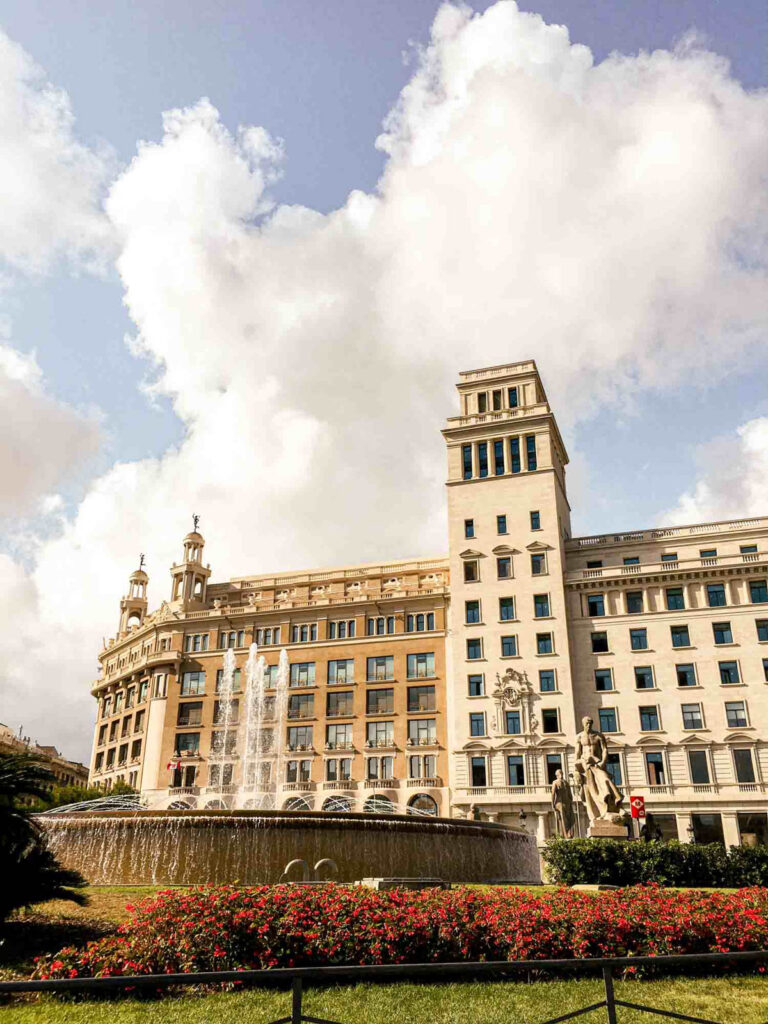
Placa de Catalunya
Your 3 day itinerary for Barcelona kicks off in Placa de Catalunya, often referred to as the heart of Barcelona. Two of Barcelona’s most famous streets start from here – La Rambla, a wide promenade in the old city; and Passeig de Gracia, lined with beautiful modernist buildings. Therefore, it is said to bridge the old and the new city.
You will most likely cross through the Placa de Catalunya multiple times on your Barcelona 3 day itinerary. The bustling square is surrounded by shops, restaurants, and monuments, and hosts many festivals and concerts. It is a popular meeting point for both tourists and locals alike.
The plaza was opened in 1927 by King Alfonso XIII. The large square covers an area of 5 hectares, and is home to numerous sculptures, monuments, and fountains. Many of these were built by various well-known Catalonian artists, including Josep Clara, Josep Subirachs and Eusebi Arnau.
Address: Plaça de Catalunya, 08002 Barcelona
Las Ramblas
Continue by walking down the bustling Las Ramblas, arguably the most famous street in the city.
The tree-lined promenade spans 1.2 kilometers, and connects Placa de Catalunya to the Christopher Columbus Monument at Port Vell. It is home to many hotels, shops, restaurants, attractions, and monuments. It is one of the most iconic landmarks in the city, and one that many people identify with the city.
It is albeit very, VERY touristy – but you can’t visit Barcelona and NOT at least pass through Las Ramblas. I did spend very little time on the streets though, often preferring to take smaller streets instead. It is very busy and very crowded and pretty much all hours in the day.
A word of caution here – because it is such a tourist spot, Las Ramblas is notorious for pickpockets. Keep a VERY close watch on your belongings here and never let your guard down!

La Boqueria Market
Mercat de Sant Josep de la Boqueria (or just La Boqueria) is not only one of Barcelona’s top tourist attractions, it is also known as one of the best markets in all of Europe and in the world. The giant market is said to have been around since 1217.
Walking up and down the rows of stalls is like a feast for the senses – it is a harmony of sights, sounds, smells, and flavors.
For a fun experience, take a tour through the market – which also comes with a paella cooking class at the end!



There are an endless array of vendors selling everything from fruits, vegetables, meats, spices, nuts, confections, and more. Several people told me that the candy vendors here are they best, but they seemed to all be closed when I was there (on a Monday). The best things here are the fruit and juices here – they are all fresh, flavorful, and cheap!
You can spend hours wandering here and snacking on the vendors’ offerings. After browsing through the market, I suggest having lunch here, as there are several restaurant stalls as well.

One recommendation for lunch is El Quim de la Boqueria, which was a recommendation from both my best friend and my orthodontist. The stand is tiny and it is always busy – you might have to stand around for a bit to wait for a spot to open up, but I promise it’s worth it!
You’ll find a menu of inventive Spanish dishes here. The signature dish is the squid and eggs, which is what I ordered, and recommend! The squid is super juicy, and the eggs soak it up perfectly. They also give you some bread, which will soak up all the juices once you’ve demolished the rest of the dish and leaves you wanting more!
Keep in mind that La Boqueria is closed on Sundays, so plan accordingly (I was not aware and showed up to find everything shuttered on my first attempt. Oops).
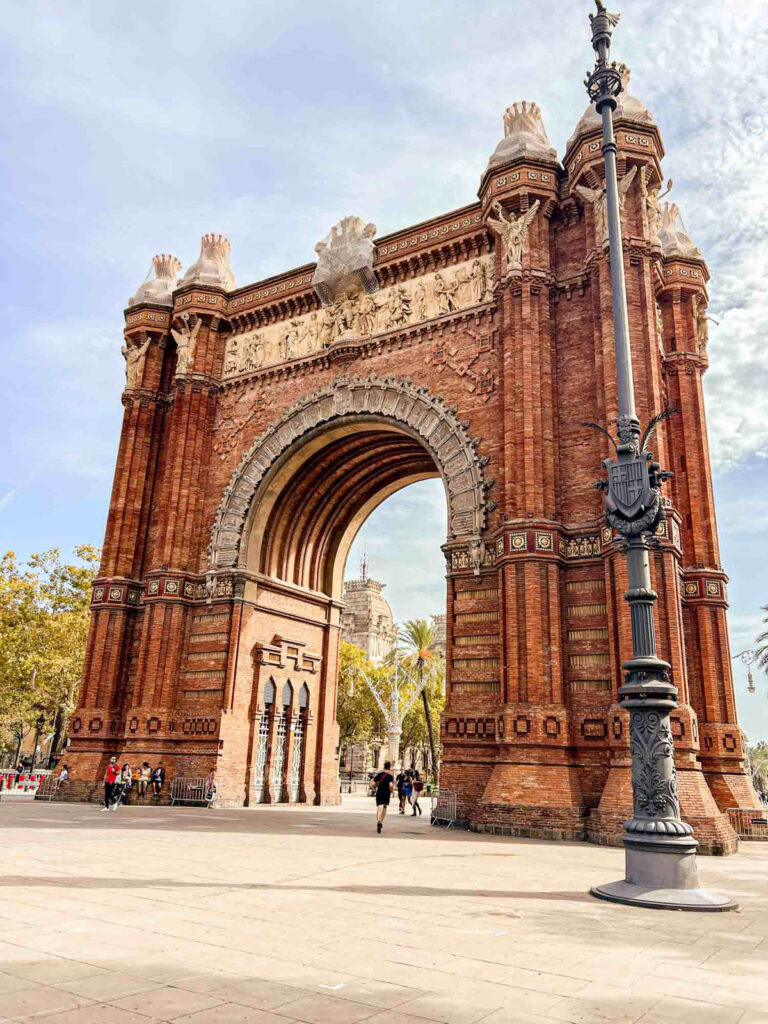
Arc di Triomf
You can’t miss the Arc di Triomf as you walk down Passeig de Sant Joan. It is one of the most iconic and recognizable monuments in Barcelona.
The giant brick arch was built in 1888, when Barcelona hosted the Universal Expedition. It serves as sort of a gateway for the modern Barcelona, and as an entrance to the neighboring Parc de la Ciutadella.
It is similar to the Arc de Triomphe in Paris, but what sets this one apart from other victory arches of its kind is that the Arc di Triomf is made of red brick.
Carved into one side of the arch are reliefs that symbolize agriculture and industry, and on the other, commerce and art. On top of the arch are the shields of the 49 Spanish provinces, presided over a coat of arms of the city of Barcelona.
There is usually a crowd of people gathered in front of the arch, and I only passed through it super quickly, so I missed snapping a photo. However, you can’t help but miss it as you walk down the street.
Parc de la Ciutadella
Once you pass through the Arc di Triomf, you will end up in the Parc de la Ciutadella. The beautiful 74 acre park is a green oasis in the middle of a bustling city, where you can find a sense of peace and calm after a busy day.
The park has many attractions, including a boating lake, a collection of statues, a tropical greenhouse, and is also home to the Barcelona Zoo and the Catalan Parliament buildings.
However, the highlight here is the ornamental fountain, which was designed by Josep Fontsere, with the help of a young Antoni Gaudi! It is also one of the most photogenic places in the city, and the perfect place to end a busy day.

Barceloneta
You might not think of Barcelona as a beach town (I certainly didn’t), but at its core, that’s technically what it is.
Ok, so Barceloneta is a man-made beach that was created for the 1992 Olympics, and is not exactly a beautiful white-sand beach. Still, it’s worth a stop on your Barcelona itinerary for 3 days.

The beach, palm trees, and the emblematic skyline makes it one of the most iconic sights in Barcelona. Passeig Martim is the main street here that goes down the beachfront, and a stroll down the path is a must. At the end of the path is the W Hotel, one of the most iconic buildings in the city.
It is the perfect way to end the first day of your 3 day Barcelona itinerary because you can hang out at one of the beach-side bars, people-watching with a fruity cocktail in hand. It is the perfect place to relax when your feet inevitably give out and you just want to sit and chill. I definitely enjoyed sitting here, watching the sunset, with sangria in hand.



It’s also got plenty of amazing restaurants + bars to end your day at! Here are a few suggestions for where to eat in Barceloneta:
- Bitacora: This ended up being one of my favorite places that I ate at on my first trip to Barcelona. Tucked into a quiet corner of Barcelona, Bitacora has a menu full of traditional Catalan tapas. It was the perfect opportunity to try Bombas (sorta like croquetas with a spicy sauce), and Fiduela (like paella made up of broken rice noodles). The portions are huge, but the prices are affordable, and everything I had was delicious. Also the sangrias here are huge AND cheap!
- Jai Ca: Jai Ca is one of the most traditional and well-known tapas places in the area. It can get super busy and sometimes overwhelming here, but the tapas are worth it. I enjoyed sitting at the bar and watching the flurry of activity here, while enjoying my tapas and sangria. The vibe here is a super classic Spanish diner style, with marbled tables, checkered floors, and vintage posters all over the wall. The fried seafood dishes here are especially tasty (I loved the squid)!
- L’Arros: If you’re traveling to Barcelona solo and craving paella, then L’Arros is a good option. I was dismayed to find that most places won’t serve paella to you if you were dining alone, as they are meant to come in a huge platter and be shared amongst multiple people. L’Arros was one of the only places that had single portions of paella. It isn’t amazing by any means, but it was still decent and hit the spot.
Barcelona Itinerary: DAY 2 (Gothic Quarter, El Born, Montjuic)

Gothic Quarter
Barcelona’s Gothic Quarter dates back over 2000 years and was the heart of the city during its Roman and medieval times. Even though I came to find out later that much of the current buildings here were built in the 19th and 20th century, you can see some of the remnants of these times here (like the Roman and medieval walls and the remains of the Roman temple), and its labyrinth windy, narrow cobblestone streets and ornate architectural details definitely take you back in time.
It is also the city’s main tourist hub, so at times it can be crowded AF and unpleasant. Because of this, I suggest wandering the streets early in the morning to enjoy some peace and quiet so you can really be transported back into time and wonder what life was like back then.
This is also a perfect opportunity to take a walking tour, during which you’ll see the highlights of the neighborhood and learn more about its unique history. For a fun experience, you can even take a walking tour that includes a tapas crawl (and plenty of wine)!
Be sure to set some time to wander through the Gothic Quarter – yes, even if you’re trying to see Barcelona in 3 days. Some of the highlights here include the Pont de Bisbe, a Flamboyant-style bridge which connect two buildings on Carrer Bisbe; Placa de Reial; and the Aguilar Palace, which is now the Picasso Museum.
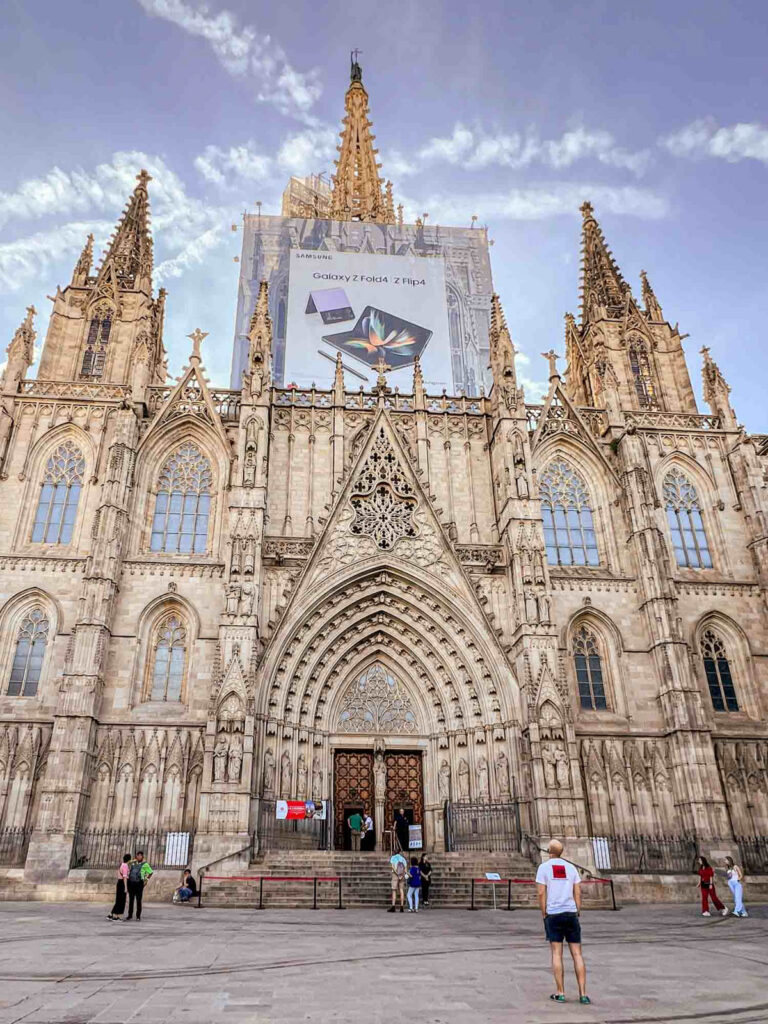
Barcelona Cathedral
While you explore the Gothic Quarter, be sure to make a stop to check out the stunning Barcelona Cathedral. It is a stunning example of Gothic architecture, and the focal point of the Gothic Quarter.
The cathedral is formally known as Cathedral of the Holy Cross and Saint Eulalia, named after Saint Eulalia, its co-patron saint, along with Saint La Mercèbut. However, locals refer to it as “La Seu,” which means “the seat.” It is the city’s main Catholic church, the seat of the diocese of Barcelona.



The enormous church is 93 meters (305 feet) long and 40 meters (131 feet) wide, and towers more than 50 meters (164 feet) high. It has mind-blowing Gothic details on its facade and in the interior, with its pointed archways, the ribbed vaults, and the many gargoyles, which can be seen on the roof. It’s not quite as massive as the Cathedral in Seville, but it’s still HUGE!
The cathedral dates back to the Roman Empire, and a basilica has stood in this very site since 343 AD. The cathedral in its present form started construction in 1298, and took over 600 years to complete – the main building was completed in 1460, the Gothic facade in 1889, and finally, the central spire in 1913.


Even if you’re church-ed out from visiting a bunch of other cathedrals across Spain and Europe, I still recommend a stop here. Why? While the inside of the cathedral is similar to many others in Europe, this one also has a rooftop, which is a unique experience that is specific to the Barcelona Cathedral.
Sadly, they were doing construction on the cathedral when I visited so there was ugly scaffolding on the spires when I went up to the rooftop. Still, it was worth going up there to check out the stunning views of the city – you can see the Sagrada Familia, the Montjuic Castle, as well as Tibidabo!


Lunch at Bar de la Pla
I discovered Bar de la Pla on my last visit to Barcelona and it is now one of my favorite restaurants in the city. In fact, I loved it so much that I ended up coming back a second time!
Bar de la Pla has a menu full of modern tapas with unique flavor combinations. Yes, it’s a tapas restaurant, but you’ll find such interesting and creative takes on it. After I found myself kinda sick of the traditional tapas (I didn’t another croqueta, *thankyouverymuch*), I was so glad to find Bar de la Pla.
I also appreciated that they were willing to make half portions of most of the dishes that they offer. This allows you to try more things – which is especially clutch if you are visiting as a solo traveler!
The staff here was super friendly and offered so many recommendations based on what your preferences were. All in all, an excellent dining experience that I’ve been wholeheartedly recommending to everyone!

Palau de la Musica Catalana
Barcelona is a city famous for its remarkable architecture, and the Palau de la Musica Catalana is one of the highlights. It is a shining example of the Catalan Art Noveau style of architecture, which was popularized by Gaudi, but this is not a Gaudi building. The Palau designed by Lluis Domenich i Montaner, who is a contemporary of Gaudi.
It is the only concert hall listed on the UNESCO World Heritage list, which makes it worth seeing on your Barcelona itinerary for 3 days. The details on the facade, in the terrace, and throughout its halls is absolutely breathtaking. Many world-class orchestras, choirs, composers, singers, and recording artists have performed on its stage since the venue opened in 1908.


You can choose from a self-guided visit or guided one-hour tour. Having done both, I appreciated the insight into the background of the Catalan Art Noveau style on the tour, but I appreciated being able to take as much time as I needed to take photos and to savor all the details of the building. You really can’t go wrong with either option though – it just depends what your priorities are.
Another option for seeing the inside of the Palau is to see a performance here – I’d love to do that someday, as it seems like such a magical venue!
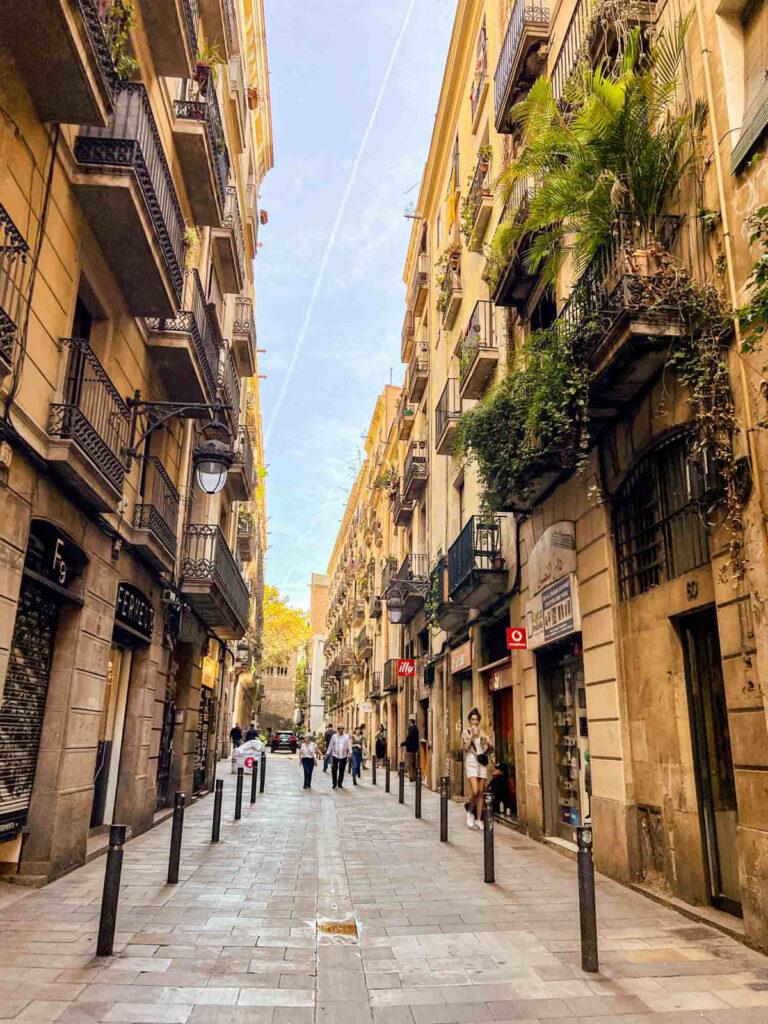

El Born
After your tour at the Palau, be sure to set aside a few hours to wander through the surrounding El Born neighborhood. It is hard not to get lost in the maze of narrow medieval streets, adorned with funky street art, colorful pennants, and intricate balconies.
The neighborhood is full of trendy designer boutiques, hip cafes, restaurants, and bars to check out. It is home to some of the oldest buildings in the city and is full of history, but is also one of the most liveliest areas in the city.
It’s also home to some acclaimed museums, including the Picasso Museum, one of the most well-known in Barcelona. The museum features one of the most extensive collection of Picasso’s works in the world, and gives an insight into the artist’s formative years. The museum also has a gorgeous terrace!
This was my favorite area to explore in Barcelona, thanks to the picturesque streets, cool street art, and unique local businesses. You can easily get lost for several hours, wandering the streets and popping in and out of all the cool shops here!

Montjuïc
Montjuïc is the most famous hill in the city, although it isn’t the tallest (that title belongs to Tibidabo). There is plenty to do and see on Montjuïc, which makes it a perfect place to spend a few hours in the late afternoon/early evening of day 2 of your 3 day itinerary for Barcelona.
Many of the attractions on Montjuïc were erected as part of the 1929 World Fair, including palaces, pavilions, parks, botanical gardens, sports stadiums, and exhibition rooms. In addition, there were new stadiums built for the 1992 Olympics.
Getting to Montjuïc is half of the fun. You can take the bus or metro to the Paral-lel station, from where you can hop on the funicular. However, the most fun way to get to Montjuïc is to take a cable car, from which you can catch sweeping views of the entire city.
Once you get to Montjuïc, there’s plenty to see and do – they can literally keep you occupied for an entire day. As you are trying to see Barcelona in 3 days, you’ll have to prioritize and only have time to do a few.
Here are some of the highlights of the attractions in Montjuïc:
- Montjuïc Castle: This imposing fortress has stood here since it 1640 to guard and control the city. It’s played a significant role in the city’s history since then. As it is on the summit of Montjuïc, you can take in some spectacular views of the city from here.
- Joan Miro Foundation: This museum was created by the artist himself, and not only displays a large number of his own works, but also aims of promoting the work of young experimental artists.
- Barcelona Botanical Gardens: This beautiful green space displays plant life from 5 geographical regions – Australia, California, Chile, South Africa, and the Mediterranean Basin – and is a lovely place to wander for a bit.
- Museu Nacional d’Art de Catalunya (MNAC): Boasting over 260,000 works in its collection, this is the largest art museum in Barcelona.
- Poble Espanyol: This open-air architectural museum features mini Spanish villages that represents the various regions of Spain. It’s similar to Skansen in Stockholm and a fun place to learn about the country’s architecture, culture, food, and traditional arts and crafts.
- Olympic Ring: This area of Montjuïc was renovated for the 1992 Olympics and is beautifully landscaped, with many water features and architectural elements.
- Magic Fountain: This is one of the most famous attractions in Montjuïc, drawing millions of visitors every year. The fountain is nice during the day, but the real highlight is the light show that takes every evening, featuring a spectacular array of light and sound. There are over 3000 water jets here that shoot up water up to 52 meters in the air!
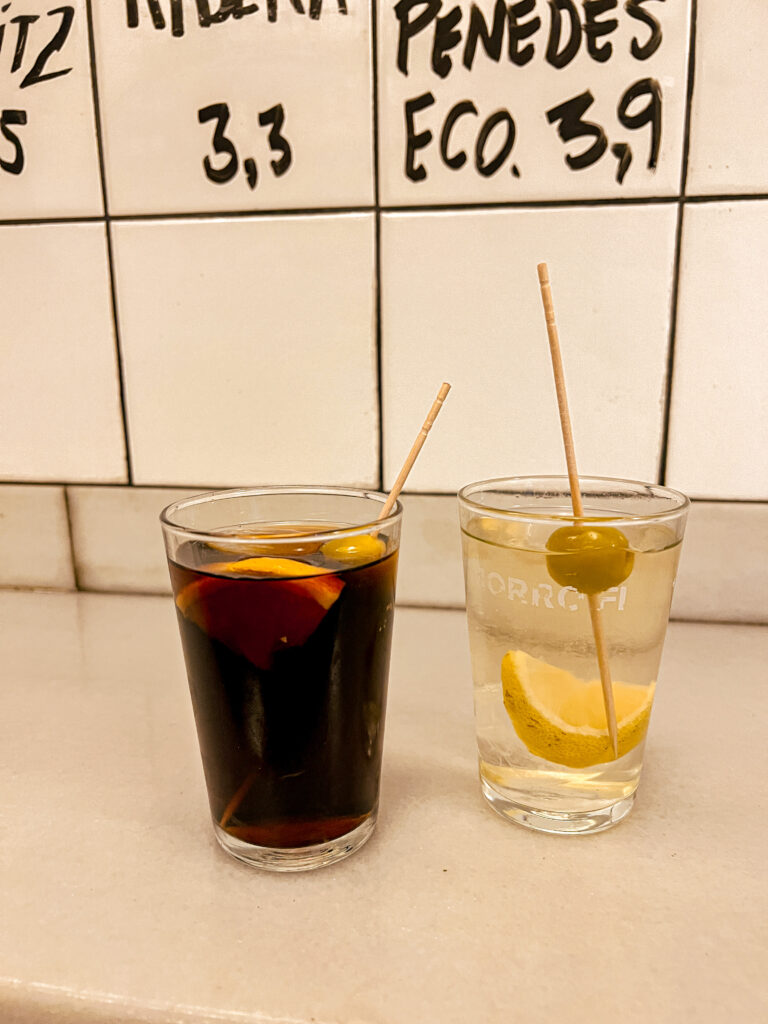
Pre-dinner Vermouth at Morro Fi
Vermouth is basically *the* drink of Spain, and what better than to enjoy a glass of it before dinner at one of the best vermuterias in town.
Morro Fi is pretty tiny, and only fits about 15 people inside. It’s always busy and you’ll find tons of locals hanging out here, which is how you’ll know it’s good stuff!
If you’re not familiar with vermouth, it is a bittersweet, fortified wine that is infused with booze and botanicals. Although it originated in Italy, the Spanish have embraced it and it is the drink of choice in town. There are two types of vermouth – dry (the kind you put in martinis), and sweet. The sweet stuff is what the Spanish enjoy as an aperitivo, served on the rocks.
My first impression of vermouth was that I wouldn’t like it it and that it’s not my thing; however, if there was once place to try it, it was in Barcelona (sort of like how you *have* to try port in Porto). And I was glad I did, because I really ended up enjoying it!
It had the perfect mix of sweet and bitter, and the botanicals gave it a refreshing mouthfeel. My boyfriend said it kind of tasted like an alcoholic Coke in a way, and I thought that was pretty spot-on.
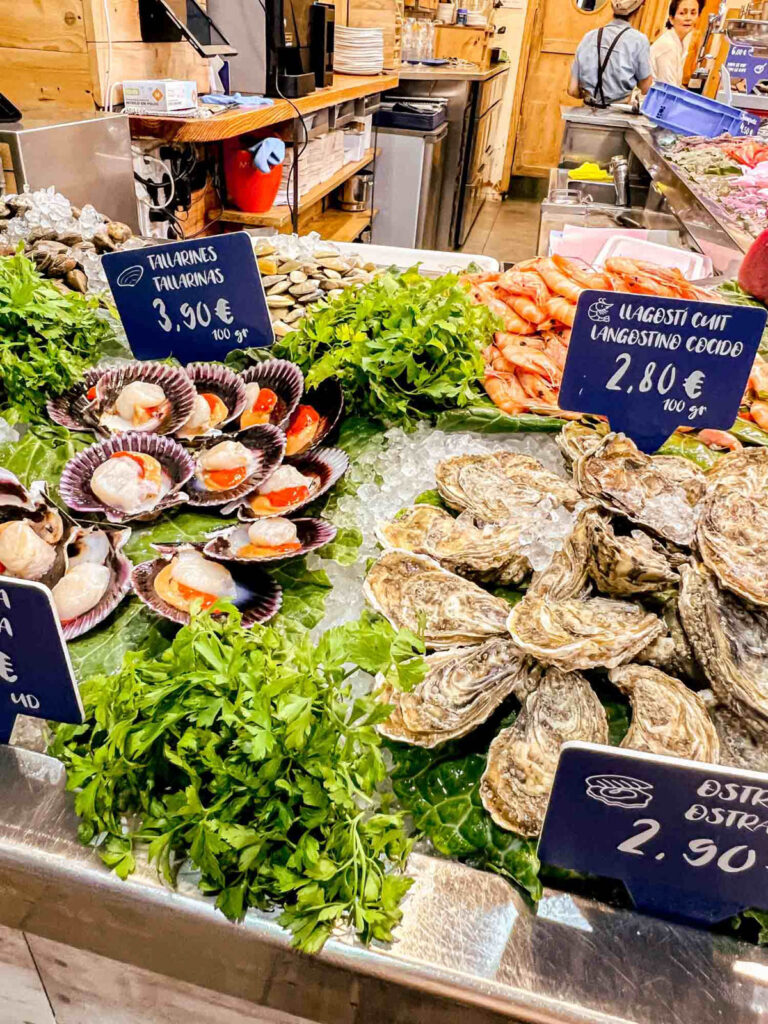

Dinner at La Paradeta
Dinner at La Paradeta is a must on your 3 day itinerary for Barcelona – especially if you are a seafood lover! Barcelona is known for its fresh seafood, and La Paradeta is one of the best places in the city to enjoy it. They have locations all over town, which makes it super convenient as well.
It’s also got a unique concept – you simply pick out the items that you want to eat. They’ll weigh it for you, and then cook it for you. The method of preparation depends on what you order, but everything we had was delicious!
Barcelona Itinerary: DAY 3 (Gaudi’s Masterpieces)
You’ll spend the last day of your 3 day itinerary for Barcelona exploring some of Gaudi’s most well-known architectural creations. It was such a highlight for me to be able to see these buildings in real life, and each of them were so unique and beautiful in their own way.
Of course, there are still more Gaudi buildings in Barcelona, but as you are trying to see Barcelona in 3 days, you won’t have time to see them all.
To maximize your time and to get more of an insight into the life and works of Gaudi, you may want to consider this World of Gaudi tour. It takes you to his top works (Casa Batllo, Sagrada Familia, Park Guell), with a knowledgeable guide and arranged transportation. It’s an excellent option for when you want to have all the details taken care of you, so you can just show up, see the sights, and learn more about them on a fun and interesting day!

Casa Batllo
Casa Batllo (pronounced “Bat-leo”) is one of Gaudi’s signature works, and absolutely a must-see on your 3 days in Barcelona.
Gaudi was commissioned by the Batllo family, one of the most prominent families in Barcelona, to refurbish an existing building om Passeig de Gracia. What he transformed it to is an absolute architectural wonder. You can really see his creativity and genius come alive while walking through the rooms.
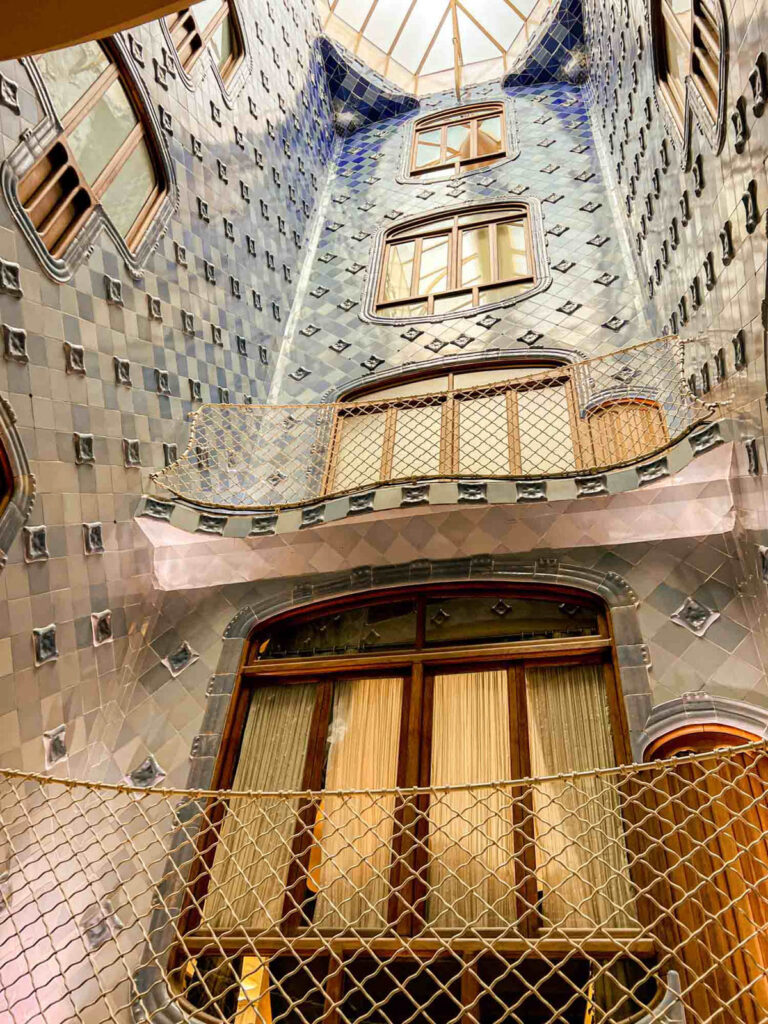

It is highly recommended that you purchase the early access ticket, which will allow you to visit Casa Batlllo 30 minutes before it opens to the general public. As Casa Batllo is one of the most popular attractions in Barelona, getting an early start means that you’ll get to avoid the crowds – it can get *super* busy here!
While all tickets include an audio guide, the early access ticket also has a unique augmented reality experience loaded on a tablet. It was so interesting to see how each of these concepts are reflected in the house’s architectural elements!
If you can’t get the early access ticket, I recommend upgrading your standard ticket to the gold option. This also includes the augmented reality tablet, as well as skip-the-line privileges to expedite and enhance your visit.

Originally, the building was set to be demolished and rebuilt, but was ruled out. Gaudi was given full creative freedom on the project, and he unleashed many of his most unique ideas and concepts on the house. Because of this, Casa Batllo is considered by many to be his signature work, and an architectural masterpiece.
The house eschews straight lines, draws inspiration from nature (particularly from marine life), and incorporates organic elements into its design. The house is also sometimes called the “house of bones,” which refers to the structural designs of its facade. The rooftop terrace also draws inspiration from the dragon of St. George’s legend. During the summer, Casa Batllo hosts various concerts and events on this very rooftop.

Casa Mila – La Pedrera
I’ll admit that my first time in Barcelona, I opted not to visit Casa Mila, Gaudi’s other famous building, because I found it plain in comparison to his other works. I just went to see the outside and opted to not go inside. Then, after I got back home, I saw photos of the rooftop terrace here and I started kicking myself.
While unassuming from the outside, this is known as one of Gaudi’s most creative works, renowned for its functional and constructional innovations. So, my next time in the city, I made sure to add it to my Barcelona 3 day itinerary.
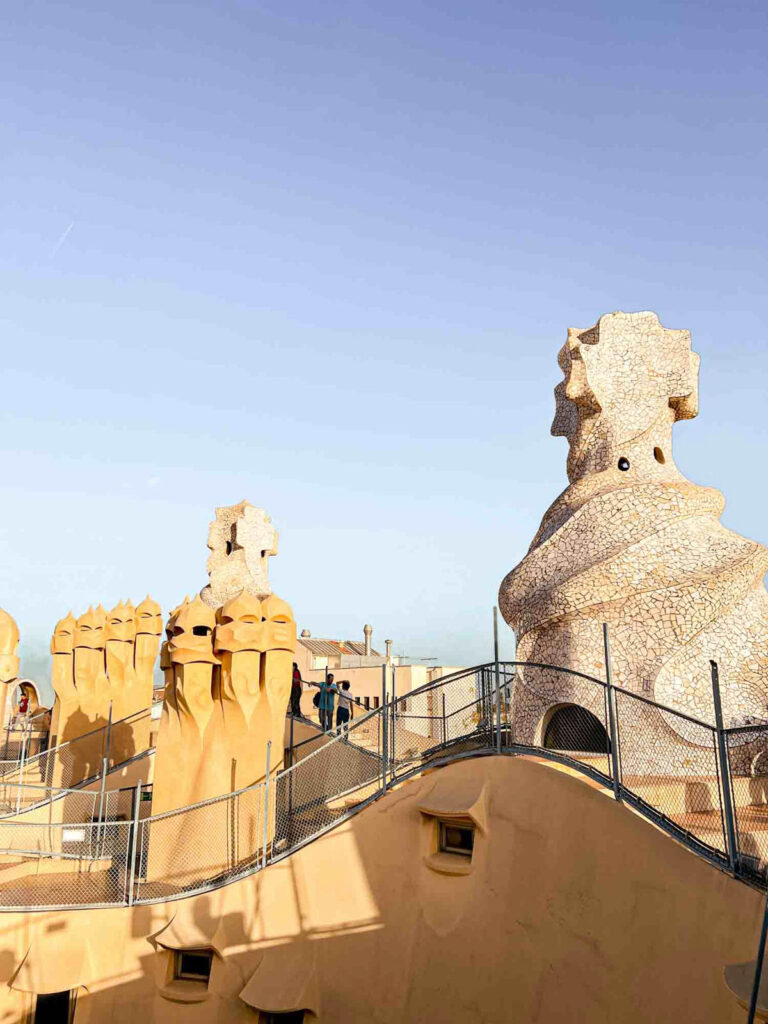

The rooftop is the most impressive part of the house, featuring some impressive looking chimneys, which are constructed to look like soldiers guarding the house. It’s got some incredible views of the city as well.
I highly recommend purchasing a skip-the-line ticket, which will save you a bit of time. Each ticket also comes with an audio guide.
In the evenings, a spectacular audiovisual show takes place on the terrace. Casa Mila’s rooftop terrace and stairwells are illuminated with multiple projections that are set to music – sooo cool! You can enjoy this performance with a glass of cava in hand, which comes with your ticket.
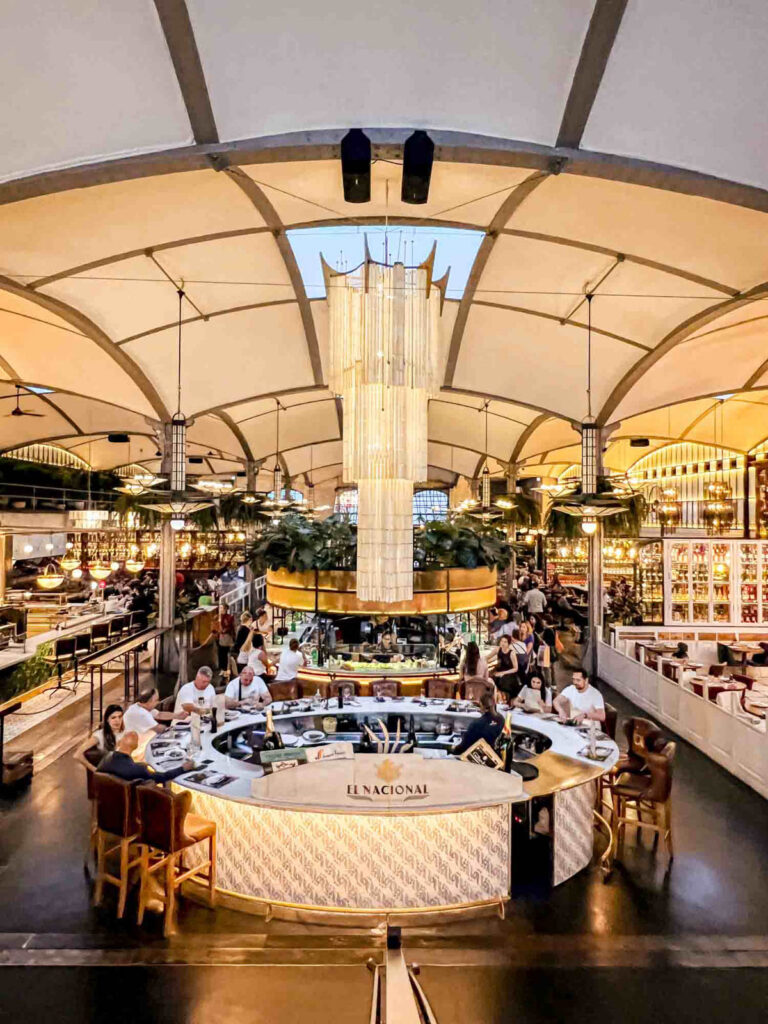
Lunch at El Nacional
Next stop – lunch! The L’Eixample neighborhood has tons of options for food, but my suggestion is to stop into El Nacional.
Housed in a beautifully restored 19th century building, El National is a high-end Spanish food hall that has multiple options to choose from. If you’re familiar with the concept of Eataly, El Nacional is kinda like the Spanish version of that – it’s got several eateries all representing a different facet of Spanish cuisine.
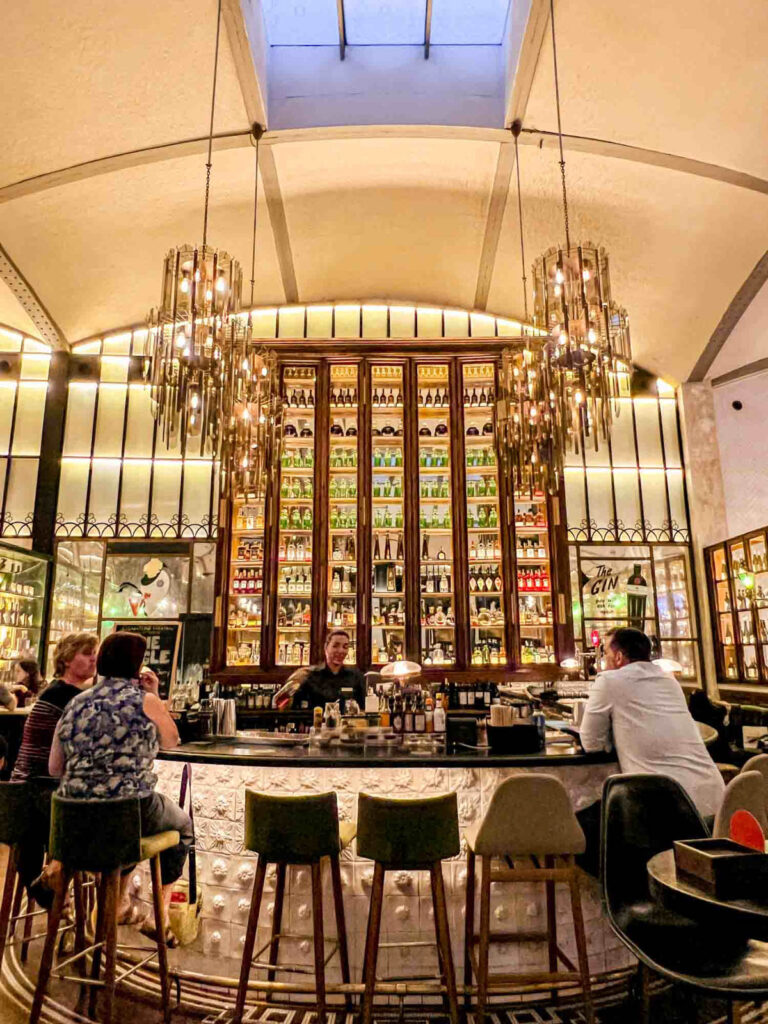
You’ll find a paella restaurant, a tapas joint, a steakhouse, and a deli-style place for lighter bites. There’s also a cocktail bar, oyster bar, and a bar with cured meats and cheeses. Plenty to choose from depending on what you’re in the mood for!
Not only that, the space is just absolutely stunning, with Art Deco details, chandeliers, and more. I enjoyed taking a second to take in all of the beautiful details here!

Sagrada Familia
Probably the most famous of Gaudi’s works, the Sagrada Familia is also the most popular tourist site in Barcelona, attracting some 3 million visitors a year. It alternates with the Alhambra in Granada as the #1 or 2 attraction in Spain every year.
Just one look at the structure and it’s easy to see why it’s so so many people visit – it’s unlike any church you will ever see.
And because of its popularity, it is ABSOLUTELY IMPERATIVE that you book your tickets to the Sagrada Familia ASAP! I saw so many people getting turned away at the ticket office, and I felt so sad for them as it truly is one of the most mind-blowing sights that you’ll ever see.
This is one instance in which I wish I had opted to do a guided tour with skip-the-line access as it’s such a unique piece of architecture. It also allows you to skip all the queues to help maximize your time! At the least, I recommend purchasing a ticket with an audio guide so that you can learn more about the Sagrada Familia.
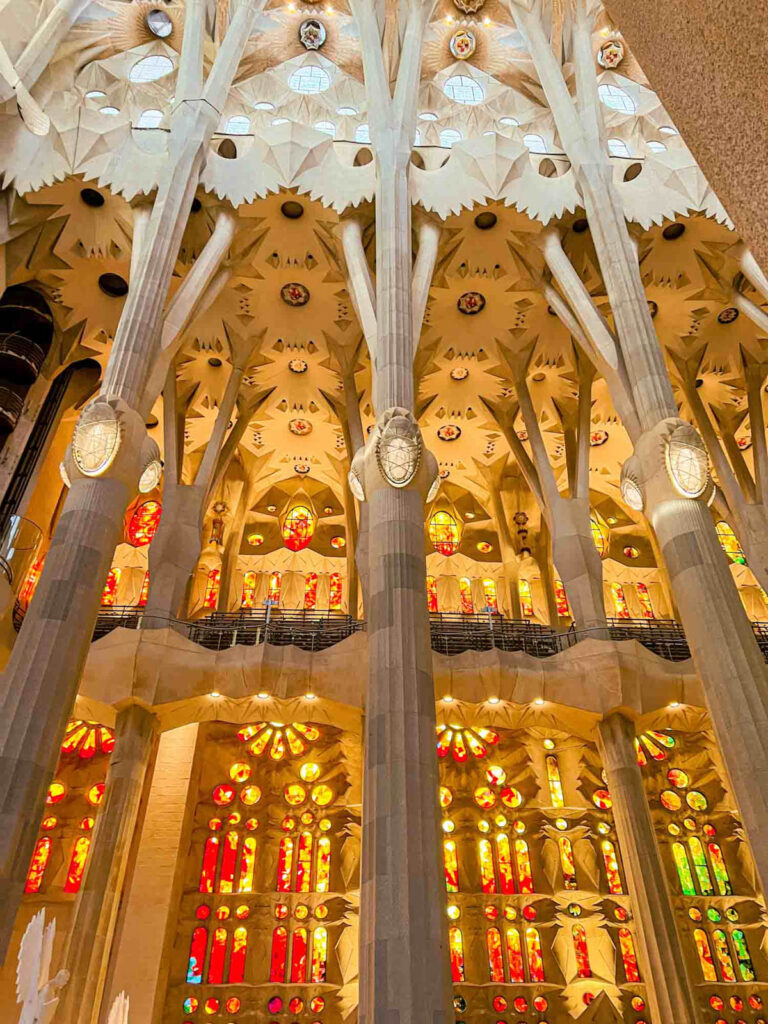

I’m going to be honest here and say that for the longest time, I didn’t see what the big deal was about the Sagrada Familia. The church looks rather stark and plain from the outside, and dare I say it, maybe even kinda ugly from the outside. That all changed when I actually saw it in person – the details on the facade are absolutely mind-blowing!
Trust me, you just have to see it to believe it. The church has been under construction since 1882 (that’s 141 years as of present writing, guys), and isn’t slated to be completed until 2026, to coincide with the centennial of Gaudi’s passing.
While you should definitely admire the cathedral from the outside, you absolutely need to see it in person. The interior of the Sagrada Familia is really what makes it one of the most unique churches in the world. Even if you’re on a budget, if you only pay for one thing in Barcelona, make the Sagrada Familia the one. It is absolutely worth every penny.
Even after going to so many churches around Europe last year (most notably the Duomo in Florence and the Notre Dame in Paris), it was unlike anything I had every seen before.
You can also opt to get up close and personal with one of the towers of the church (the Passion or Nativity towers). I personally haven’t done this but I heard it’s worth it to get up close to the towers and see all the details on them!


Before you step into the cathedral, spend a bit of time walking around the perimeter of the church to admire all the details that are carved into the facade. One side portrays the nativity scene, and the other portrays a somewhat graphic rendition of the crucifixion of Jesus Christ. It is absolutely spectacular.
I spent over an hour inside the church, just admiring all the light, color, and details that are present inside. It is an absolute magical sight. The design is whimsical, almost like something out of Dr. Seuss, which makes it unique from all the other churches out there.
I loved seeing the the play of shadow and light, and seeing the interior be bathed in a prism of colors from the colorful stained glass windows. Seriously mind-blowing. Definitely the highlight of my 3 day itinerary for Barcelona!
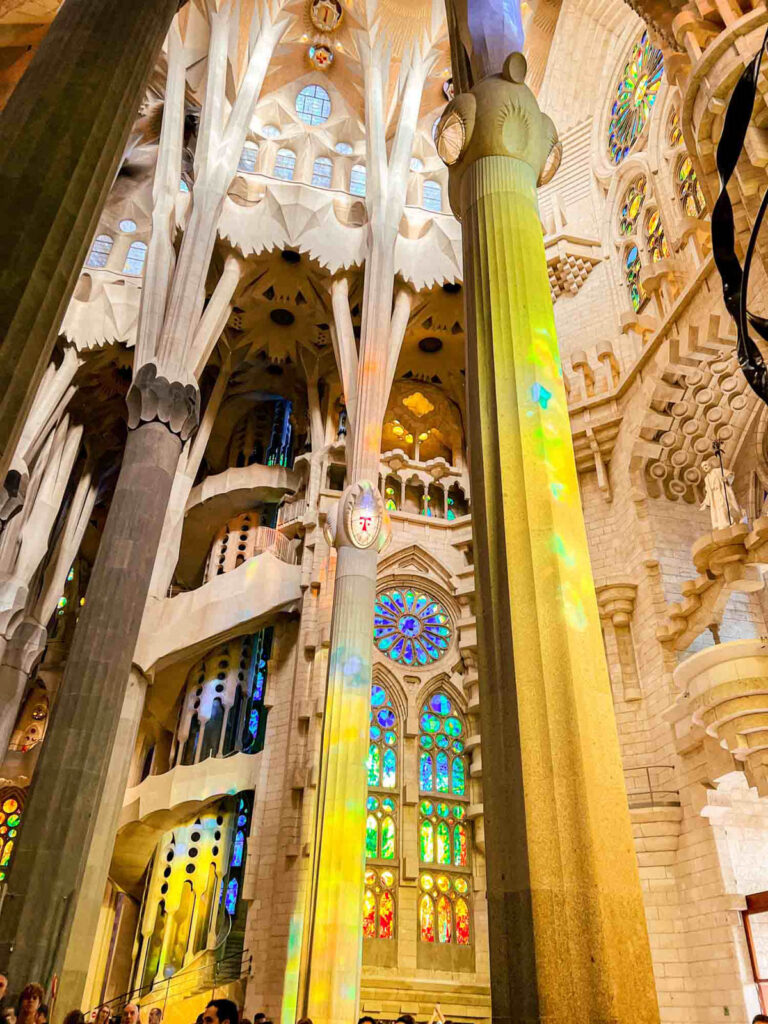

Before you leave, absolutely do not miss the museum located on the basement (the entrance is located as you make your way to the gift shop). I missed this on my first visit, and I don’t know how because it was seriously so interesting and fascinating!
There’s tons of exhibits about Gaudi’s life, the progression of the Sagrada Familia, the history of Barcelona, as well as plaster models of the Sagrada Familia. You can even sometimes see people working in the studio here too, depending on what day you visit.
Afterwards, head across the street to the Placa de Gaudi Park, which is the best place to photograph the outside of the church in its entirety.
All in all, I probably spent about 2 hours to see the outside of the Sagrada Familia, take in the inside, check out the museum, and to snap photos from the park.
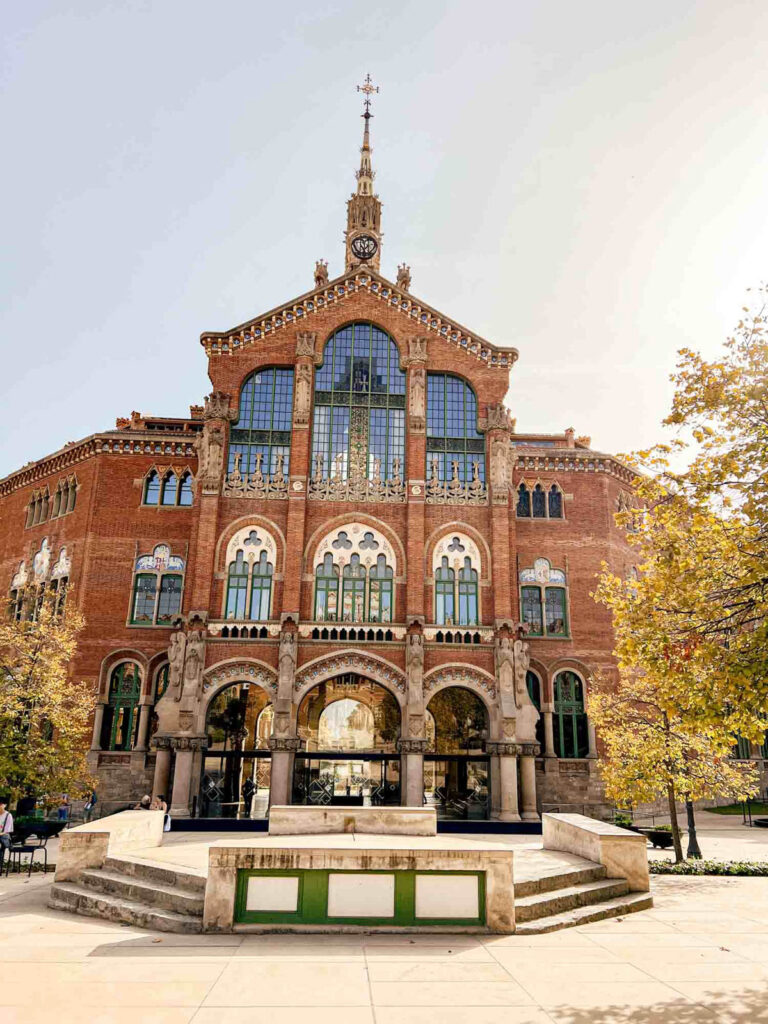
Recinte Modernista de Sant Pau
While the Recinte Modernista de Sant Pau isn’t a Gaudi design, it’s one of the most stunning works of architecture in Barcelona, that it’s worth making a stop on your itinerary. If you’re running tight on time, you may have to skip it, but otherwise I highly recommend making a visit!
Designed as a garden city, Recinte Modernista de Sant Pau was a creation of Lluis Domenich i Montaner, one of Gaudi’s contemporaries and the same architect behind the Palau de la Musica Catalana. Believe it or not, the buildings in the complex as used as a hospital for over a century!


The buildings here are all shining examples of Catalan Art Noveau architecture, with vibrant colors and unique architectural details. While you check out the buildings, an audio guide will tell you of its history as well.
It’s definitely worth stopping for a couple hours to check it out!
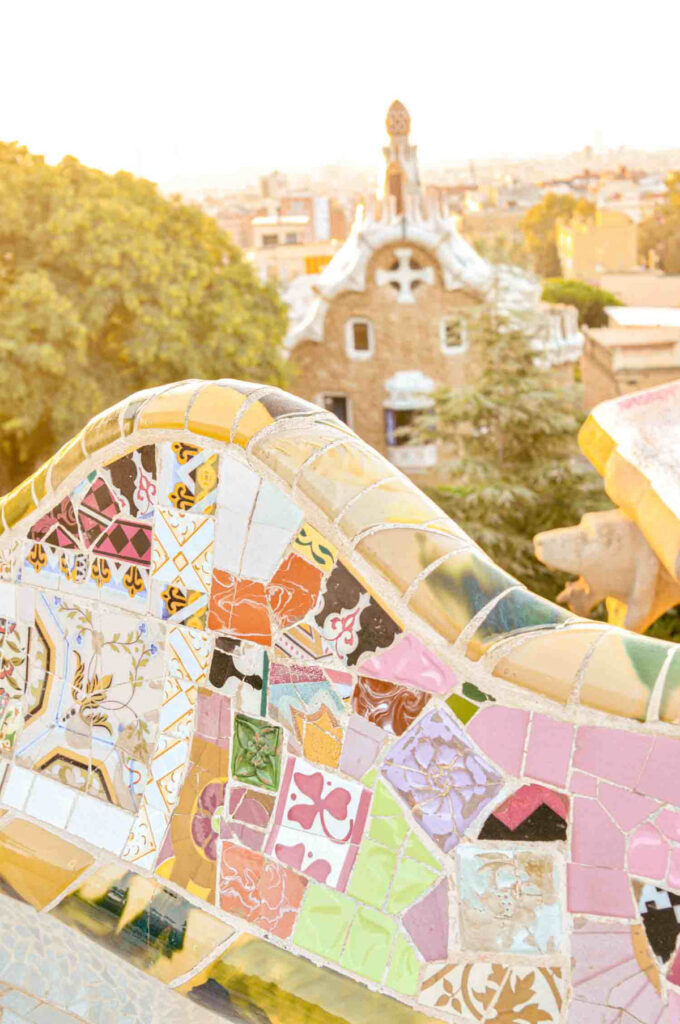
Park Guell
Gaudi’s magical wonderland was originally created to be a private community for wealthy people. When the project failed because it went way over budget, it was given to the city of Barcelona and turned into a public park, and it became designated as a UNESCO World Heritage site in 1984.
Make sure you buy your skip-the-line tickets ahead of time, as they tend to sell out in advance (and the line gets long)! It is the second most visited attraction in Barcelona, and one look and it’s easy to see exactly why.


Gaudi takes inspiration from nature and organic forms in his creations here, which come alive in the greenery. While most of the park itself is free to explore, you will need to buy a ticket (which is fairly affordable at €10) to get into the Monumental Zone, which is where all of Gaudi’s main works are located.
Some of the highlights here are the entrance square, with the salamander fountain; the Hypostyle Hall, with its 6 meter tall Roman columns and mosaic ceiling; the corrugated mosaic bench; and the gingerbread-style houses out front, one of which Gaudi took up residence in his later years, and now serves as museums.

Aim to visit around sunset time – get here at least an hour before. It might be a bit busy, but it’s known as one of the best places to watch the sunset in Barcelona, so it will be worth it! You can see the entire city, and watch the sky change over Gaudi’s whimsical creations. Such a magical sight to end your Barcelona 3 day itinerary!
Other Things to see in Barcelona in 3 Days
If you want to see more of Barcelona in 3 days, check some of these places out:

Tibidabo
Tibidabo is the highest natural point in the city. It’s a bit of a trek from the city center, but getting there is half the fun and definitely worth doing if you have some extra time in Barcelona.
At over 500 meters tall, Tibidabo is the highest mountain in Barcelona and offers sweeping panoramic view of the city, the hills, and the Mediterranean Sea. It is also home of an amusement park, a communications tower, and a fairy-tale like church (when viewed from the hills).
To get the best view of the church, apparently you should head for the hills…or go on a sketchy ride in the amusement park.
You can choose to spend the day here and hang out at the amusement park, or you can just come for the views, like I did. You can pay to take in the views from the observation deck that is at the top of the amusement park, but the better view in my opinion (that is also free), is from the base of the church.
From here, you truly get a sense of how expansive Barcelona is – you can see everything in the city (my favorite part of the view was the towers of the Sagrada Familia sticking out in the skyline). For even more epic views, you can choose to go up the church’s towers.
Tibidabo can be a bit of a trek to get to but the trek itself is a fun adventure. To get to Tibidabo, you must take a RENFRE train (line L7) to the Avenida Tibidabo stop.
From here, the journey gets a little bit fun – you get on the Tibidabo tram, and then transfer to the funicular. There are some excellent views from this part of the trek, so just take it all in.
El Bunkers del Carmel
This one is a local favorite, and is also supposed to have an amazing view of the city. This one was another one that I just ran out of energy to go to. Once a site for anti-aircraft guns, the bunkers now one of the most scenic viewpoints in the city.
Both tourists and locals gather here, bring picnics, and enjoy the view – especially on warm summer evenings. It is a bit of a trek from the city center, but if you have extra time during your 3 days in Barcelona, it is supposed to be absolutely worth it! (I opted to go to Tibidabo instead and ran out of time).
Disclosure: This post contains affiliate links. This means that if you make a purchase or booking, I may receive a small commission at no additional cost to you.
What would you do on your Barcelona 3 day itinerary?
You might also like:
The Most Instagrammable Places in Barcelona
The Perfect Spain Itinerary for Barcelona + Andalucia
2 Perfect Days in Seville
3 Days in Lisbon
2 Days in Florence
Liked this post? Save this 3 day itinerary for Barcelona to Pinterest for later!


Caroline is a Southern California based traveler, writer, and photographer. She travels all around California, the US, and the world in search of the most colorful places, the most delicious food, and bucket-list adventures. Her aim is to inspire other travelers discover how to add more adventure and joy to their lives. On Pictures & Words, you’ll find detailed guides + itineraries, along with vibrant photos to help you plan the the most epic trips. When she’s not traveling, Caroline also runs half marathons.

Patti
Saturday 29th of February 2020
Just as gorgeous as I remember it back from 25 years ago! I neeeeeeed to go back!
Nicola Lavin
Tuesday 25th of February 2020
Barcelona was one of those cities that I didn't immediately love but your blog post is making me want to give it another try.
Marina
Monday 24th of February 2020
Aww you make me wanna go back there! I’ve been several time already but it’s such a beautiful city! Thank you for this amazing guide, ill be sure to take it with me when I go
Suvarna Arora
Sunday 23rd of February 2020
I may go this year. This is so helpful.
Helga
Sunday 23rd of February 2020
Amazing guide! I'm traveling to Barcelona next month for my birthday. This filled up the gaps in my plans. Thanks xx